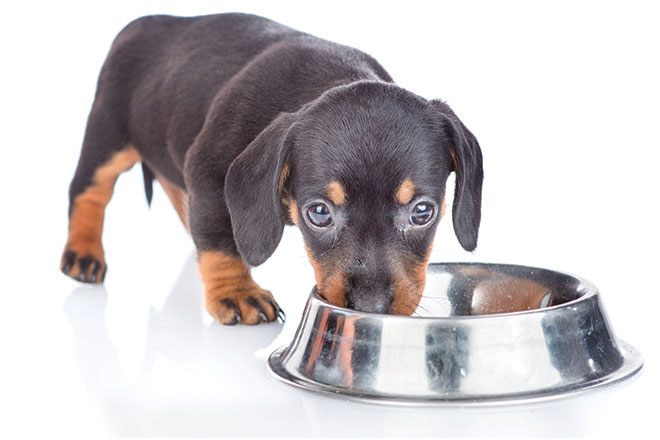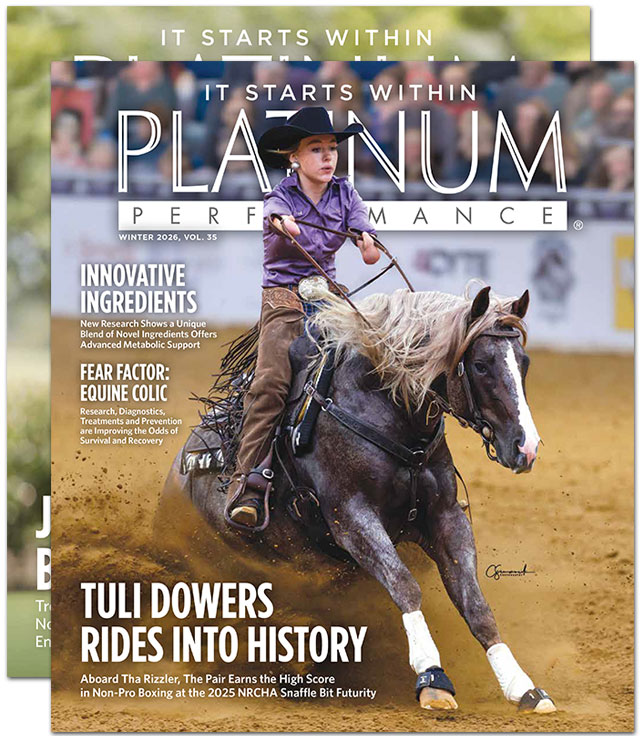How You Can Ensure Your Young Pet is Off to a Solid Nutritional Start Amid an Abundance of Choices
The day has arrived to pick up the newest family member — your puppy! Whether a breeder helped or you found your puppy at a local animal rescue, one of the first questions is: “What food do I feed?” And if you’ve been searching for the perfect puppy food, often your next question is: “Why are there so many choices?”
One Size May Not Fit All
Finding the right puppy food involves a conversation with your veterinarian who can guide you to a product with key ingredients that support the optimal growth and development of your puppy based on age and its breed. Keep in mind that a one-size-fitsall feeding approach is not ideal because different breeds have specific nutritional needs for growth during the pivotal first 12-18 months of life. Here are some dietary considerations to help you determine what may be best for your new canine companion.
In a puppy’s first six months, you will see rapid growth and development. Growth should be steady to prevent problems that can occur with too much (overnutrition) or not enough balanced food (undernutrition). Breed-specific growth charts are helpful in tracking the weight gain during your puppy’s first year. Because puppies have different nutritional needs than adult dogs, it is essential to maintain a diet that is specifically formulated to support growth. For a large- or giant-breed puppy that will grow into an adult that weighs 70 pounds or more, you’ll need a food that is designed to support growth of a large-breed puppy to ensure proper skeletal development. Puppy foods contain essential nutrients in higher or different concentrations than adult dog diets to support growth including amino acids, calcium and phosphorus in specific ratios, and essential fatty acids like DHA (docosahexaenoic acid) that are important for brain and vision development in the younger animals.

Did You Know?
Platinum Performance® supplements can be beneficial for dogs at all stages of life.
Puppies can be started on a supplement program as soon as they begin consuming solid food.
Advanced Nutrition for Puppies
Puppies need essential dietary nutrients to help them develop into healthy adult dogs. Dietary fat is an important source of calories and also provides growing puppies with essential fatty acids. Growing dogs require dietary linoleic acid (a polyunsaturated omega-6 fatty acid) as well as the omega-3 fatty acids alpha linolenic acid (ALA), docosahexaenoic acid (DHA) and eicosapentaenoic acid (EPA). Linoleic acid supports skin and coat health and can be found in vegetable oils, such as safflower, sunflower, corn or sesame oil. ALA is found in plants and plant oils, such as flaxseed and flaxseed oil. DHA plays a crucial role in brain and retinal development in young puppies and is an important nutrient for cognitive development. Puppies that consume DHA in their post-weaning diet and/or that are born to dams fed DHA may be easier to train. Both DHA and EPA are included in cold-water fish, such as salmon, and can also be produced commercially by algae.
While optimal nutrition won’t guarantee a perfect puppy, it will significantly increase the odds that your pup will mature into a healthy adult dog. Many aspects of raising puppies are difficult to control; nutrition is one part that is easily managed and is vital to nurturing a happy and healthy puppy.
“Work with your veterinarian to guide you in the selection of food for your unique puppy.”
— Meri Stratton-Phelps, DVM, MPVM, DACVIM, (LAIM, Nutrition), Platinum Performance® Veterinary Nutritionist
Considerations to Help the Process
Because there are so many choices of commercial puppy foods, selecting what’s right for your puppy can be daunting. Here are a few simple considerations to make the selection process easier as well as some general nutritional recommendations for a happy and healthy puppy. Be sure to remember to confirm your puppy food choice with your veterinarian.
1. Follow the guidelines.
Check if the food is manufactured by a company that follows the guidelines described by the World Small Animal Veterinary Association (wsava.org), a global community of more than 200,000 veterinarians from 114 member associations. WSAVA outlines nutritional standards and production quality control rules that help to ensure that a pet food will meet the health needs of your puppy.
2. Read the label.
Make sure the food meets the nutritional needs of growing puppies. Review the label for a statement that confirms the food is formulated to meet the needs of growth or all life stages. In the case of large- and giant-breed puppy foods, the manufacturer’s label should state the food is formulated to meet the needs for growth of large-sized dogs. It is critically important to select a food designed for puppy growth, so it contains the correct amount of energy, protein and other essential nutrients. For large-breed dogs, the concentration and ratio of calcium to phosphorus in the puppy growth food, and the concentration of calories will be modified to promote proper growth and development of the large-breed puppy’s bones throughout the first 18 months.

3. Trial-tested formulas.
Choose a puppy food that has been tested in feeding trials. This information is listed on the food label. If feeding trials on the product have not been done, look for a statement that the food is nutritionally complete and balanced. For growing puppies, the food should meet minimum nutrient but not exceed the maximum nutrient requirements established by the Association of American Feed Control Officials. AAFCO is an independent organization of feed regulators that guides feed ingredient definitions and labeling standards for animal feed.
4. Feed, don’t fatten them.
Measure out the recommended amount of food for the weight of your growing puppy. To promote a healthy growth rate and to help avoid health problems that can develop later in life from obesity, monitor your puppy’s growth and weight gain. While your veterinarian weighs your puppy during regular visits, you should keep track of its weight using a scale at home. A growing puppy with a slightly lean body condition is preferred. Check with your veterinarian to find out what the safe rate of weight gain is for your puppy.
5. Consider calories and limit treats.
Keep in mind a puppy food’s calorie content (usually in a calorie/cup basis), the kibble size and the need for special nutritional management associated with any health problems. While it may be fun to offer treats, feeding excess or high-calorie treats can lead to unwanted weight gain. Your veterinarian can advise on a reasonable number of treats for your puppy and offer alternative reward suggestions.
Newborn Puppy: From Mother’s Milk to Solid Food
The first milk that your puppy consumes is from the dam. This special milk, colostrum, contains immunoglobulins essential to support a puppy’s immune system and needs to be consumed within the first 16 hours after birth.1 Colostrum also contains numerous proteins and growth factors that help your puppy’s development.1 The dam produces milk that is energy dense and high in protein, fat and other essential nutrients. The milk is adequate to support the healthy growth of a puppy through its first 3 to 4 weeks of age. After that, the puppy can be slowly transitioned to a food that supports growth. A puppy food gruel can be made by blending an appropriate moist puppy growth food with warm water in a 1:1 ratio, or by using a 1:3 ratio of dry puppy food kibble to warm water.2 Over the next seven days, the gruel can be gradually changed over to the puppy food by reducing the added water. By 5 weeks of age, puppies should be eating puppy food. Puppies are usually weaned between 6-7 weeks of age. When transitioning from milk to gruel, it’s important to make gradual dietary changes to reduce the risk of digestive upset. During this period, closely monitor your puppy and notify your veterinarian for any vomiting, diarrhea or other signs of gastrointestinal illness.

Puppy Nutrition Timeline
First 16 Hours: Colostrum, found in mother’s milk, must be consumed within the first hours of birth.
3-4 Weeks: Milk is adequate to support your healthy puppy.
4 Weeks: Over a 7-day period, transition puppies from gruel to solid food.
5 Weeks: Should be eating puppy food.
6-7 Weeks: Usually fully weaned.
12-18 Months: Regular dog food will now fulfill dietary requirements. For larger breeds, puppy food should be continued until 18 months.
Your pet's veterinarian is the best source for advice about your puppy.
Literature Cited
1. Rossi L, Lumbreras AEV, Vagni S, et al., (2021). Nutritional and Functional Properties of Colostrum in Puppies and Kittens. Animals, 11(11)3260, pp. 1-17.
2. Debraekeleer J, Gross K, Zicker S. (2010). Feeding Growing Puppies: Postweaning to Adulthood. In: Hand M, Thatcher C, Remillard R, Roudebush P and Novotny B., eds. Small Animal Clinical Nutrition. Topeka, KS: Mark Morris Institute, pp. 311-319.




